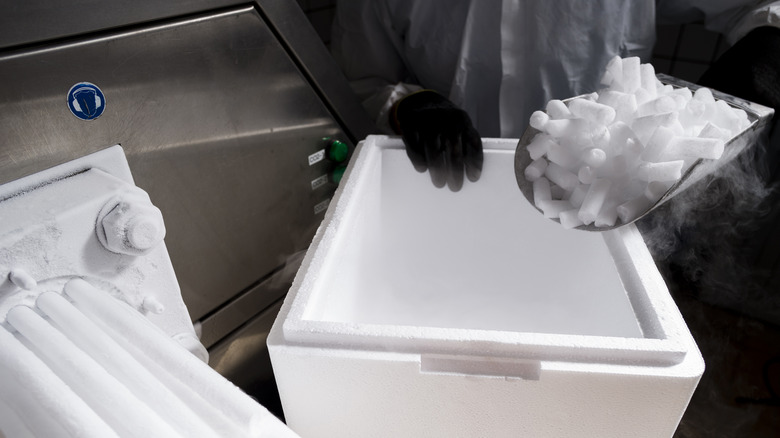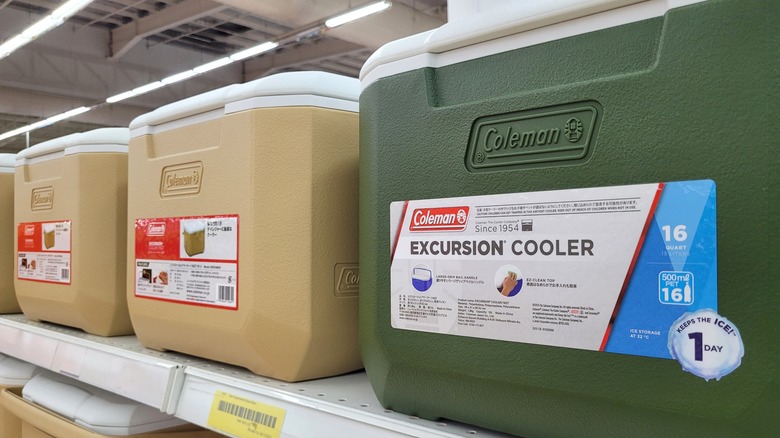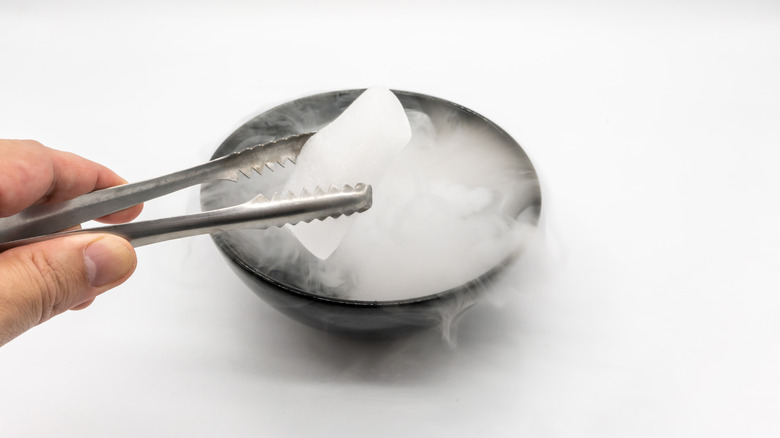How To Safely Use Dry Ice In Your Coolers This Summer
We may receive a commission on purchases made from links.
Dry ice is best known for the role it plays in creative mixology, adding a note of drama to drinks as basic as a bowl of Halloween punch. It can also be used to perform TikTok tricks like carbonating fruit. But dry ice has a practical side, as well. If you're planning a camping trip or a day at the beach, there's no better way to keep ice cream or popsicles frozen in your cooler. Still, dry ice is not without its dangers. That's why The Takeout consulted with Max Levin, managing director at Snapl Solutions Inc., to find out the proper way to use dry ice. "A lot of what we do involves handling temperature-sensitive goods, so dry ice comes up often," Levin explained.
"Dry ice is incredibly effective for keeping things frozen without the slushy mess of melted ice," Levin told The Takeout. That's why dry ice is such an excellent method of shipping frozen foods. As he pointed out, however, it does have its issues. "The downside is how cold it gets — it can freeze things solid or cause freezer burn if items aren't packed right. Also, since it turns directly into carbon dioxide gas, it can be dangerous if there's no ventilation."
What kind of cooler is best suited to dry ice?
If you plan to use dry ice to keep your picnic refrigerated, first check to make sure that your cooler is up to the task. Dry ice reaches temperatures of up to -109 degrees Fahrenheit. In Levin's experience, "Hard-sided, thick-walled coolers like Yeti or Pelican are the best bet because they hold up to extreme cold and insulate really well." He doesn't recommend coolers made of Styrofoam or thin plastic, as the super-cold temperatures might make them crack. Soft-sided coolers also shouldn't be used with dry ice since their linings can be damaged. When in doubt, do a little research to see if your specific cooler is rated for use with dry ice.
Another thing to watch out for is how tightly your cooler seals. You might think airtight is a good thing since you want to keep cold air in and hot air out, but Levin says it doesn't work that way with dry ice. "Definitely don't seal dry ice in an airtight cooler. As it turns to gas, pressure can build up and blow the lid open — or worse." If you do have a cooler with a tight seal, you'll need to crack it open a bit, and maybe use some napkins or rags to ensure it stays cracked. A safer approach, however, would be to purchase a cooler with a pressure release valve.
How to pack a cooler with dry ice
Before you even think about packing your cooler with dry ice, be sure to have the necessary safety equipment handy. "Always use gloves or tongs when handling it," Levin said — but not just any old gloves will do. They need to be heavy and insulated to protect you from the extreme cold which can give you frostbite. You might also want to wear safety goggles just in case the ice does explode.
As for how you pack your cooler, Levin says that dry ice placement depends on what you want the ice to do. "If you're trying to freeze something, dry ice goes underneath," he said. "If you're just trying to keep items cold, put it on top." He advised placing cardboard, newspaper, or towels between the ice and the food to create a barrier since this will help you control the cold exposure.
Levin summed up his dry ice safety tips by reassuring us that it need not be dangerous if the proper precautions are taken. In his words: "Treat dry ice with respect. Use it in ventilated spaces, wear protective gloves, and keep it out of reach of kids or pets. As long as it's stored properly (never in a sealed container), it's totally safe to use."


